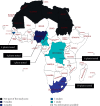A Systematic Review of In Vitro Activity of Medicinal Plants from Sub-Saharan Africa against Campylobacter spp
- PMID: 32508957
- PMCID: PMC7245682
- DOI: 10.1155/2020/9485364
A Systematic Review of In Vitro Activity of Medicinal Plants from Sub-Saharan Africa against Campylobacter spp
Abstract
Introduction: Campylobacter spp. are zoonotic bacteria that cause gastroenteritis in humans and may cause extraintestinal infections such as Guillain-Barré syndrome, reactive arthritis, and bacteremia. Resistance to antibiotics is an increasing concern in the Sub-Saharan Africa; thus, search for alternatives such as plant-based active ingredients is important in order to develop new drugs.
Objectives: To present a systematic review of in vitro and in vivo studies of the antibacterial activity of medicinal plants from Sub-Saharan Africa against Campylobacter spp. Methodology. Studies published until March 2020 on medicinal plants used against Campylobacter spp. from each country of Sub-Saharan Africa were searched on PubMed, Science Direct, AJOL, and Google Scholar. Articles were selected based on the existence of information regarding in vitro and in vivo activity of medicinal plants against Campylobacter spp.
Results: A total of 47 medicinal plants belonging to 28 families were studied for in vitro activity against Campylobacter spp. No plant was studied in vivo. Plants from Fabaceae family were the most commonly studied. The plants with the strongest antimicrobial activities were Cryptolepis sanguinolenta and Terminalia macroptera. The root extracts from these plants were effective, and both had a minimal inhibitory concentration (MIC) of 25 μg/ml. Seven pure compounds were isolated and analyzed for activity against Campylobacter spp. The compound cryptolepine from C. sanguinolenta was the most effective with MIC values ranging between 6.25 and 25 μg/ml.
Conclusion: Several native plants from the Sub-Saharan Africa region were studied for in vitro activity against Campylobacter spp. Some plants seemed very effective against the bacteria. Chemical compounds from three plants have been isolated and analyzed, but further studies are needed in order to produce new and effective drugs.
Copyright © 2020 Delfina Fernandes Hlashwayo et al.
Conflict of interest statement
The authors declare that there are no conflicts of interest regarding the publication of this article.
Figures





Similar articles
-
Epidemiology and antimicrobial resistance of Campylobacter spp. in animals in Sub-Saharan Africa: A systematic review.Heliyon. 2020 Mar 9;6(3):e03537. doi: 10.1016/j.heliyon.2020.e03537. eCollection 2020 Mar. Heliyon. 2020. PMID: 32181402 Free PMC article. Review.
-
A systematic review and meta-analysis reveal that Campylobacter spp. and antibiotic resistance are widespread in humans in sub-Saharan Africa.PLoS One. 2021 Jan 27;16(1):e0245951. doi: 10.1371/journal.pone.0245951. eCollection 2021. PLoS One. 2021. PMID: 33503068 Free PMC article.
-
In vitro Anti-Mycobacterium ulcerans and cytotoxic activities of some selected medicinal plants and an indoloquinoline alkaloid.Int J Mycobacteriol. 2021 Jan-Mar;10(1):60-65. doi: 10.4103/ijmy.ijmy_243_20. Int J Mycobacteriol. 2021. PMID: 33707373
-
Cryptolepis sanguinolenta activity against diarrhoeal bacteria.J Ethnopharmacol. 1994 Oct;44(2):73-7. doi: 10.1016/0378-8741(94)90071-x. J Ethnopharmacol. 1994. PMID: 7853867
-
Contribution of Sub-Saharan African medicinal plants to cancer research: Scientific basis 2013-2023.Pharmacol Res. 2024 Apr;202:107138. doi: 10.1016/j.phrs.2024.107138. Epub 2024 Mar 11. Pharmacol Res. 2024. PMID: 38467241 Review.
Cited by
-
Ethnobotany, Ethnopharmacology, and Phytochemistry of Medicinal Plants Used for Treating Human Diarrheal Cases in Rwanda: A Review.Antibiotics (Basel). 2021 Oct 9;10(10):1231. doi: 10.3390/antibiotics10101231. Antibiotics (Basel). 2021. PMID: 34680811 Free PMC article. Review.
-
Back to Nature: Medicinal Plants as Promising Sources for Antibacterial Drugs in the Post-Antibiotic Era.Plants (Basel). 2023 Aug 28;12(17):3077. doi: 10.3390/plants12173077. Plants (Basel). 2023. PMID: 37687324 Free PMC article. Review.
-
Susceptibility antibiotic screening reveals high rates of multidrug resistance of Salmonella, Shigella and Campylobacter in HIV infected and uninfected patients from Mozambique.BMC Infect Dis. 2023 Apr 21;23(1):255. doi: 10.1186/s12879-023-08219-7. BMC Infect Dis. 2023. PMID: 37085752 Free PMC article.
-
Susceptibility of Campylobacter Strains to Selected Natural Products and Frontline Antibiotics.Antibiotics (Basel). 2020 Nov 9;9(11):790. doi: 10.3390/antibiotics9110790. Antibiotics (Basel). 2020. PMID: 33182474 Free PMC article.
-
A scoping review on efficacy and safety of medicinal plants used for the treatment of diarrhea in sub-Saharan Africa.Trop Med Health. 2024 Jan 3;52(1):6. doi: 10.1186/s41182-023-00569-x. Trop Med Health. 2024. PMID: 38173018 Free PMC article.
References
Publication types
LinkOut - more resources
Full Text Sources
Miscellaneous

